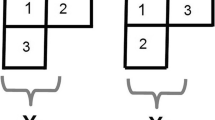Abstract
THE structure of androsterone, C19H30O2 (Fig. 1), the first male sex hormone to be discovered, was determined recently by High1 by vector coincidence methods. The space group of this compound is P21; the unit cell constants are a = 9.56 Å, b = 7.90 Å, c = 11.78 Å, = 111.36°, Z = 2, and the measured density equals 1.164 g cm−3. High's atomic positional parameters have been used to calculate the quantitative geometry of the androsterone molecule as follows. The final monoclinic fractional co-ordinates (x, y, z) were converted to Cartesian coordinates in Å (p, q, r) using the expressions p = a0x + c0z cos β, q = b0y, and r = c0z sin β, where a0, b0 and c0 are taken in the Donnay setting (a0 = 11.78 Å, b0 = 7.90 Å, c0 = 9.56 Å). The Cartesian Å co-ordinates were used, in turn, to compute a series of ‘best’ planes (Table 1) to which various geometrical features of the molecule could be referred, namely, the root mean square distances of atoms from the ‘best’ planes (Table 2), the perpendicular distance of individual atoms from the ‘best’ planes (Table 3), and the angles between the ‘best’ planes and various sub-portions thereof (Table 4). The ‘best’ plane calculations were performed on an IBM 1620 computer using the ‘best’ plane ‘Fortran’ programme of Harris and Harker2.
This is a preview of subscription content, access via your institution
Access options
Subscribe to this journal
Receive 51 print issues and online access
$199.00 per year
only $3.90 per issue
Buy this article
- Purchase on Springer Link
- Instant access to full article PDF
Prices may be subject to local taxes which are calculated during checkout
Similar content being viewed by others
References
High, Darrell F., thesis, Univ. of Washington. University Microfilms, Inc., Ann Arbor, Michigan (1962).
Harris, David, and Harker, David (unpublished results).
Author information
Authors and Affiliations
Rights and permissions
About this article
Cite this article
NORTON, D., OHRT, J. Molecular Geometry of Androsterone. Nature 203, 754–755 (1964). https://doi.org/10.1038/203754a0
Published:
Issue Date:
DOI: https://doi.org/10.1038/203754a0
Comments
By submitting a comment you agree to abide by our Terms and Community Guidelines. If you find something abusive or that does not comply with our terms or guidelines please flag it as inappropriate.



